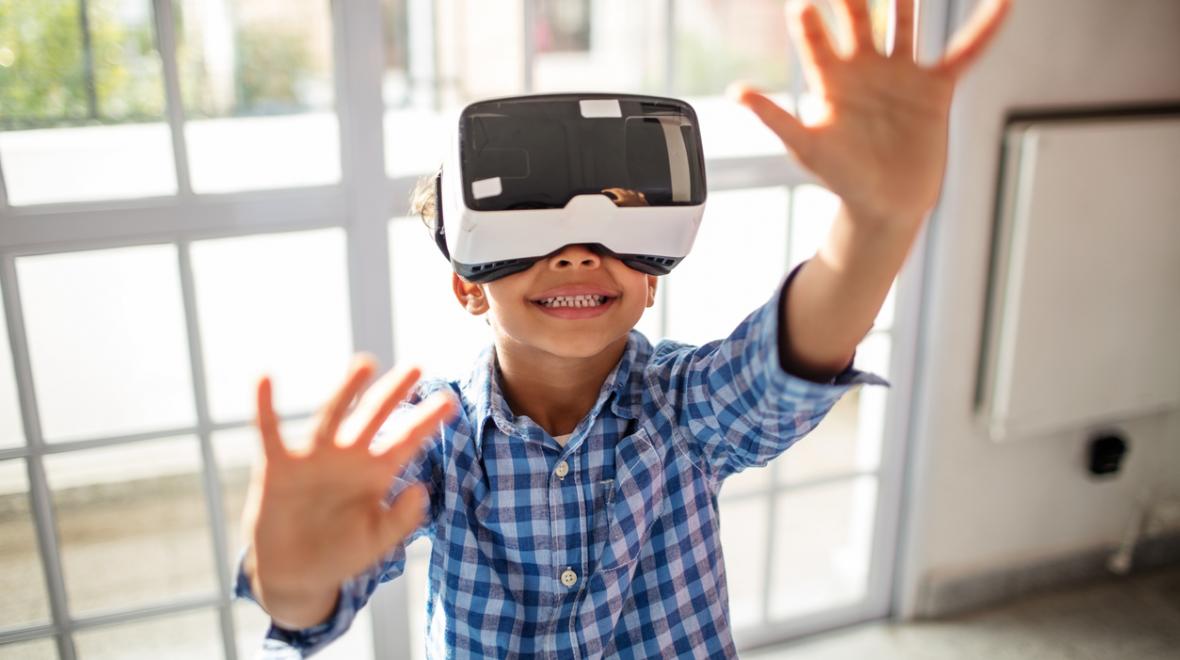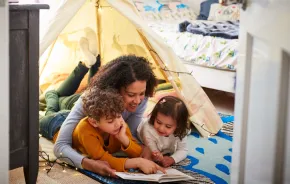
If you are like most parents stuck in the role of accidental teacher this fall (gee, thanks, COVID-19!), you may be scrambling to set up workable approaches to keep learning on track for your screen-fatigued pupils. Virtual reality can offer some exciting possibilities for home use and expanding digital literacy skills, whether for education, exercise or entertainment — or any combination of the three.
VR for education and entertainment
Kirby Shabaga, co-president of the Seattle Chapter of the VR/AR Association, has great recommendations for families wanting to explore virtual reality (VR) and augmented reality (AR). “Without having access to a headset, the simplest way to get a feel for VR is to use your mobile phone to view 360-degree photos and videos on YouTube or Facebook. I highly recommend Google Earth VR to explore our planet. It’s a fantastic feeling to travel from place to place or zoom in to your neighborhood.”
Shabaga also recommends powerful tools such as Oculus Quill (painting and animation software for VR), Oculus Medium (digital sculpting software), Google Blocks (3-D modeling software), Google Tilt Brush (a room-scale 3-D painting application) and Microsoft Maquette (a mock-up tool for spatial prototyping) for digital artists and dabblers to expand their creative horizons. “Not all applications are available on every headset, so some homework is required.”
As a podcaster and researcher, Shabaga values communication tools. “Other options are experimenting with platforms like Hubs by Mozilla, where you can instantly create a shared virtual world with friends and family, or AltspaceVR, to attend virtual meetups, host events or hang out.” Both platforms enable participation from a web browser for those who don’t have a headset.
In addition to the many free virtual field trips offered by museums from around the world, families can also watch historic events come to life through VR documentaries. The YouTube 360 channel for VR is a great place for watching 360-degree videos of all types, including thrilling action and nature videos, and immersive concerts for all age groups.
VR for fitness and exercise
Looking for ways to bolster your kid’s “remote recess”? Job Stauffer, a well-known VR fitness advocate, recommends Beat Saber, which he describes as “a quintessential VR blockbuster where players swing a red and blue light sword at flying blocks to fast-paced electronic music.” According to the Virtual Reality Institute of Health and Exercise, an independent ratings organization for VR and AR at San Francisco State University, the game helps players perform at an average activity level equivalent to playing tennis, burning about 6–8 calories per minute.
Stauffer also recommends Supernatural, an immersive fitness experience in which personal coaches deliver new workouts daily, set virtually in some of the most beautiful places in the world. As many as four family members can share a single subscription, which allows each person to create an individual profile to track their training progress.
For a geekier spin on family fitness, Vader Immortal: A Star Wars VR Series provides a three-part adventure that has players fighting the Empire by using the Force. “Ultimately, diving into VR for the first time can be exciting and revelatory — and you’ll quickly start to realize how much fun working out can be when we stop leaving all of the action to our thumbs and the characters on a screen, and start stepping into those spaces to live those experiences ourselves,” says Stauffer.
Get your head(set) in the game: Expert picks for VR headsets
Ever been curious about how to get started in VR and which headset to buy? Headsets range from a low of $5–$12 for the Google Cardboard, to under $50 for basic headsets, to hundreds for popular headsets made by Oculus, Playstation, VIVE and others.
Most headsets are built by manufacturers for those ages 13 and older, for a variety of complex reasons. For younger kids, you can focus on 2-D options or the simpler cardboard headsets. Many basic headsets require a smartphone to use, and more advanced headsets are either standalone or tethered to a computer. Check for all of the necessary computer specifications to integrate your headset with your current system, or consider possibly upgrading your setup if your family loves learning or creating with virtual reality software and applications.
Shabaga shares some of his top headset picks for families: “The device I recommend to most people is the Oculus Quest, a standalone device with an excellent interface. However, they are in high demand and [the company] recently announced that users would soon require a Facebook account as the only login method. The Samsung Odyssey+ is often a top pick for those getting started in VR. For Windows users, there are multiple Windows Mixed Reality headsets to explore.”
Educational field trips in VR
- Google Earth VR — Explore the world from totally new perspectives in virtual reality
- Google Expeditions — 100 AR expeditions safe for all ages & 900 VR Expeditions that teens and families can enjoy
- The Louvre Museum — “Mona Lisa Beyond the Glass,” a 3-D Mona Lisa experience
- YouTube VR — Documentaries, concerts and other VR videos
Creativity in VR and AR for kids and teens
For younger kids:
- CoSpaces Edu — VR/AR creation tools for the classroom
- 3DBear — AR, VR, 360-degree photos and scanning for all ages
- Morphi — Great for creating 3-D models for VR/AR, animation, game design, storytelling, graphic design and more
- Quiver — Digital aquarium, fashion, cars, coloring
- Blocksmith — Helps kids, teens and families learn 3-D design and coding
For teens:
- Unity — 3-D, 2-D, VR and AR game engine
- Unreal Engine — 3-D creation platform for photoreal visuals and immersive experiences
- Microsoft Maquette — Design 3-D models in a VR space
- Blocks by Google — Create 3-D models in a VR space
- Google Tilt Brush — Paint in 3-D with VR
- Oculus Medium — Create with digital clay in VR
- Oculus Quill — Paint and animate in VR
Exercise games
Learning, meeting and conference platforms (for teens and adults)
VR/AR organizations
- VRARA — VR/AR Association Chapter of Seattle
- Virtual World Society
- Educators in VR/Students in VR
- iLRN — Immersive Learning Research Network
- VR Health Institute











